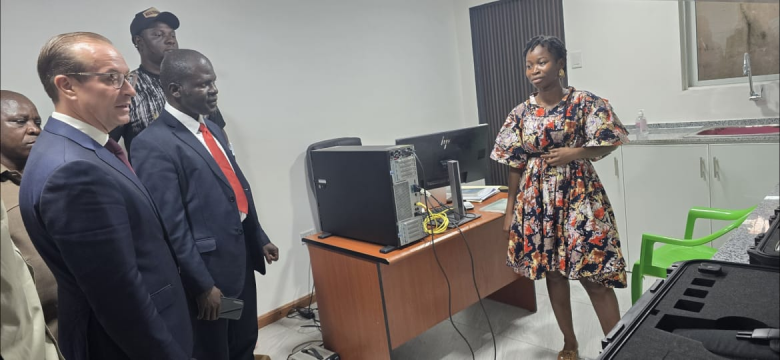
MONROVIA — Liberia has entered a new phase in its environmental and scientific development with the commissioning of the Environmental Protection Agency’s (EPA) modern Environmental and Radiation Safety (ERRS) Laboratory.
By Selma Lomax [email protected]
The commissioning ceremony, held at the EPA’s newly constructed headquarters in Monrovia, marked a defining moment in the country’s pursuit of evidence-based environmental policy and stronger inter-agency coordination.
For years, the EPA’s Environmental and Radiation Safety Department operated with limited tools and infrastructure, which severely hampered its ability to respond effectively to pollution, climate risks, and industrial contamination. The new ERRS Laboratory changes that reality, providing Liberia with the scientific capacity to conduct sophisticated analyses of water, soil, air, and radiation samples.
The facility now allows the EPA to generate reliable data on environmental and public health indicators, assess industrial impacts, and support climate action initiatives.
This development comes at a time when Liberia faces growing environmental pressures — including widespread deforestation, pollution from mining operations, inadequate waste management, and increased vulnerability to climate change.
With the new laboratory in full operation, Liberia is now better equipped to detect pollutants, enforce environmental laws, and shape regulations based on scientific evidence rather than speculation. The EPA says this marks a turning point from reactive policy responses to proactive and data-driven environmental management.
The ERRS Laboratory’s importance extends beyond the EPA itself, serving as a national scientific hub for collaboration among key government institutions. The facility will support cross-sectoral research and strengthen the country’s capacity to manage natural resources sustainably.
The Ministry of Agriculture is among the primary beneficiaries. Through the laboratory’s analytical services, the Ministry will receive critical data on soil composition, pesticide and fertilizer runoff, and water quality. This will enable policymakers and farmers to design sustainable farming practices that improve yields while protecting the environment.
For the Ministry of Mines and Energy, the laboratory provides an essential tool for ensuring greater accountability within the mining sector. For decades, illegal and unregulated mining — particularly the use of mercury in artisanal gold mining — has polluted rivers and damaged ecosystems.
The ERRS Laboratory will now enable authorities to monitor pollutants, enforce environmental compliance, and track remediation progress more effectively.
The National Public Health Institute of Liberia (NPHIL) will also benefit significantly from the laboratory’s enhanced testing capabilities. The EPA and NPHIL have already collaborated on public health interventions, including the closure of an unsanitary water bottling facility earlier this year. With the new laboratory, the two institutions can jointly analyze water samples more rapidly and accurately, ensuring that contaminated water sources are detected and addressed before they threaten public health.
The Liberia Petroleum Refining Company (LPRC) is another key partner expected to use the lab’s analytical tools to monitor petroleum-related pollution, especially in coastal areas where oil residues and spills threaten marine life. Similarly, the National WASH Commission will utilize the laboratory’s findings to ensure safe drinking water and improve wastewater management across the country.
The Food Authority of Liberia will work closely with the EPA to strengthen food safety systems through regular testing of food and water samples for contaminants, helping to prevent the spread of foodborne diseases and improve public confidence in national food standards.
Beyond its domestic impact, the ERRS Laboratory is already positioning Liberia as an emerging player in international environmental research and climate cooperation. In September 2025, the International Atomic Energy Agency (IAEA) donated a €100,000 elemental analyzer to the EPA to support “blue carbon” research — a scientific effort focused on studying how coastal and marine ecosystems like mangroves capture and store carbon.
This new capacity will help Liberia generate accurate data to support its climate adaptation strategies, enhance coastal protection, and participate more actively in global carbon markets. The technology also strengthens the country’s ability to meet international climate commitments under the Paris Agreement and related global environmental accords.

EPA Executive Director Dr. Emmanuel Urey Yarkpawolo hailed the commissioning of the laboratory as a milestone achievement for Liberia’s environmental governance. He described the facility as a “game-changer” that will transform how environmental issues are studied, regulated, and addressed in Liberia.
According to Dr. Yarkpawolo, the laboratory represents more than just infrastructure — it is a symbol of Liberia’s growing commitment to science-based decision-making and sustainable development.
He emphasized that data produced by the ERRS Laboratory will guide government agencies, development partners, and private sector actors in designing policies that balance economic growth with environmental preservation.
“This laboratory gives Liberia the capacity to understand its environment in ways that were never possible before,” Dr. Yarkpawolo said. “It ensures that environmental decisions are grounded in science, not assumptions, and that every policy we make is guided by data and evidence.”
Environmental experts and development partners have welcomed the new laboratory as a timely and transformative investment in the country’s future. It is expected to play a central role in advancing environmental education, fostering innovation, and strengthening Liberia’s resilience against the growing threats of climate change and pollution.
The commissioning of the Environmental and Radiation Safety Laboratory therefore marks the beginning of a new era for Liberia — one defined by scientific integrity, inter-agency collaboration, and national accountability in environmental management. With this facility, Liberia is not only improving its ability to protect natural resources but also reaffirming its commitment to sustainable development and global environmental responsibility.